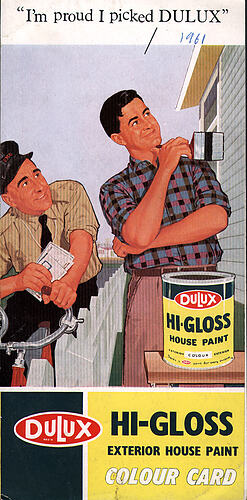Paint Preparation
Traditionally interior surface finishes consisted of lime-wash, water-based distempers (Kalsomine) and oil based paints, applied to walls and ceilings as a protective and decorative layer. This treatment was applied to renew soiled or damaged surfaces or to update the appearance of an interior in accordance with fashion trends. Decorative surfaces were often enhanced by stencilling, marbling and gilding, although the colour palette was restricted to the availability of colouring agents. Paints used during the late 19th and early 20th century were predominantly composed of linseed oil, white lead and coloured pigment. These pigments were imported into Australia and included green copper hydroxide, red and yellow oxides and Prussian blue. They were mixed into oil based paints, colour matched onsite by skilled decorators and applied in thin layers with a paint brush.
The development of synthetic alkyd paints was an important mid 20th century innovation that dramatically transformed the paint manufacturing industry. These pre-mixed paints replaced the need for onsite preparation from the 1950s. Unlike traditional paints and distempers which were mixed insitu and applied over painstakingly prepared surfaces, modern enamels could be applied to all surfaces, often in a single coat. Enamel paints were water soluble, fast drying, with a smooth matt finish. They could be purchased commercially in an array of premixed colours and finishes from the late 1940s.
Colour Schemes
Although commercially available paints offered an array of paint colours and finishes, fashion trends dictated the colour range. Throughout the late 1940s and early 1950s interior colour schemes remained relatively conservative, with popular colours including ivories, off-whites, creams, greys and pastel hues of pink, blue and green. This period was dominated by restrictions and the rationing of building materials as a result of World War II and it was not uncommon for distemper washes to still be used for decorative finishes.
Soon temperate palettes were considered to reflect the 'drab' war years and these pastel hues were replaced by an explosion of colour and texture, inspired by the strong primary colours synonymous with the Modernist movement. By the late 1950s a colour revolution was beginning to affect conventional interiors, and two, three or four bold colours might be used in one room. These colours were coordinated with decorative plastic laminates and linoleum floors to compose a 'Harlequin' effect.
In contrast to this array of vibrant surface treatments and exuberant colours, the organic architectural movement of the 1950s inspired a palette derived from nature. Colours such as buff, beige, tobacco and cinnamon were used in conjunction with unadorned surfaces featuring natural timbers, rough cement, and exposed masonry.
Compiled by Kelly Wynne, Deakin University Student, October 2008.
References:
Cuffley, P. (1993) Australian Houses of the Forties and Fifties, Five Mile Press Pty Ltd, Rowville.
Hall, W. & Hall, D. (2007)Australian 50s 60s Décor, Tandem Publishing, Malvern.
Jackson, L. (1994) Contemporary: Architecture and Interiors of the 1950s, Phaidon Press Ltd, London.
McCarthy, K. (2007). 50/60/70 Iconic Australian Houses: Three Decades of Domestic Architecture, Murdoch Books, Millers Point, NSW.
New South Wales Heritage Office (1998)Paint Finishes: Information Sheet 7.2, New South Wales Heritage Office, NSW.
Timms, P. (2008)Private Lives: Australians at Home Since Federation, Miegunyah Press, Melbourne.
The Australian Home Beautiful Magazine, April 1955, p. 59
The Australian Home Beautiful Magazine, December 1959, p. 9
Walsh, G.P. (1990) 'Taubman, George Henry (1862-1938)' inAustralian Dictionary of Biography, Volume 12, Melbourne University Press, p. 173.
More Information
-
Keywords
-
Authors
-
Article types


